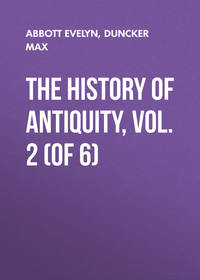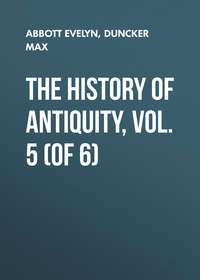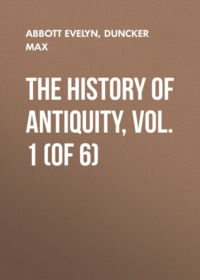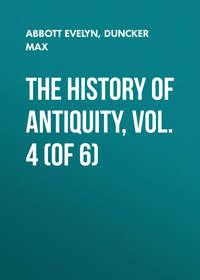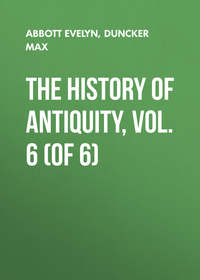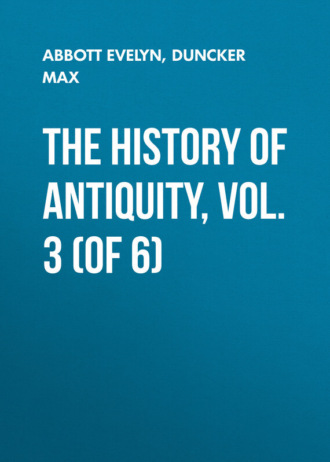 полная версия
полная версияThe History of Antiquity, Vol. 3 (of 6)
In the bloom and vigour of his years, conqueror of the Greek cities, victorious over the land of the coast, after bringing to completion the political aims of his forefathers, in possession of an inexhaustible treasure, at the head of a state carried to the limit of its natural frontiers, and flourishing in trade, commanding an excellent army, respected by his subjects, and lord of Asia Minor – Crœsus, in the year 560 B.C., had many reasons for counting himself a happy man, a ruler specially favoured by the gods. Like all Oriental princes he was not without a haughty confidence in his power and his success; he was in a high degree self-conscious. Solon, when he saw Sardis, was close upon his eightieth year. Grown up amid violent commotions in his city, amid the fierce strife of parties, with a deed of blood before his eyes, Solon had early had occasion to reflect on the plans and aspirations of men, on their lust of possessions and power, on the fortune allotted to them, on the punishments which though often late the gods awarded to unjust deeds. Beyond other men he had devoted his life to his fatherland, a canton of moderate extent. He had refused the position of tyrant in order to serve his country in a much more difficult position with unwearied devotion and perseverance. If by such fidelity he had succeeded in turning destruction aside from his community, and establishing a constitution which ensured order and freedom to it, this constitution, and with it the work of his life, which he had defended with the dedication of all his powers, was wrecked. If the form given by Herodotus to the conversation of Solon and Crœsus is a part of his mode of narration, and the observation on the envy of the deity a part of his view of life, Solon had nevertheless reason in his own bitter experience to tell the sovereign of Asia Minor that no one could be accounted happy before the end of life. Compared with his own fortune the lot of Cleobis and Bito, who died immediately after their glorious deed, the death of Tellus, who ended a good life by dying in victory for his country, must have appeared a fortune to be envied.
END OF VOL. III1
The older Zachariah mentions the land of Hadrach beside Damascus and Hamath, Zech. ix. 1, 2.
2
Fifteen miles to the north-west of Aleppo the ruin-heaps at Tel Erfad mark the site of the ancient Arpad; Kiepert, "Z.D.M.G." 25, 665.
3
A document has been preserved from the reign of Assur-nirar, belonging to the year 747 B.C., regarding the lease of a piece of land; Oppert et Ménant, "Docum. Juridiq." p. 151.
4
The list of rulers represents him as marching to the stream, i. e. to the Euphrates, immediately after his accession, and afterwards to the land of Namri, i. e. to the Zagrus.
5
G. Smith reads Zimri.
6
Nissi in G. Smith, "Disc." p. 260, but in frag. 4 Nissa.
7
So according to G. Smith [who reads Likruti].
8
Ll. 29-33 in G. Smith, "Disc." p. 260; Ménant, "Annal." pp. 142, 143.
9
Ll. 34-42, in G. Smith, "Disc." p. 261; Ménant, loc. cit. 143. The words "I possessed anew" are wanting in G. Smith; cf. Lenormant, "Z. Ægypt. Sprache," 1870, s. 48 ff. The statement about the subjugation of Bit Hamban and the regions which follow, ll. 34-37, is repeated in the inscription in Layard, pp. 17, 18, l. 17; in Ménant, loc. cit. 139. The statement about the campaign of Assurdainani is repeated in frag. 4, p. 271 in G. Smith, loc. cit.
10
This gives 745-744 B.C.: Bildanil. To the land of Namri; cf. frag. 3 in G. Smith, "Disc." p. 269.
11
Ménant translates, "city of Zikruti;" G. Smith's rendering does not give this description in this passage (p. 260), but on p. 271.
12
G. Smith, loc. cit. p. 279; Ménant, loc. cit. p. 146.
13
L. 17 in Ménant, loc. cit. p. 139.
14
Above, p. 2, note 4.
15
Frag. 1, 2 in G. Smith, "Disc." pp. 266, 267.
16
Ménant, loc. cit. p. 139.
17
The list of rulers inserts a second campaign of Tiglath Pilesar to the land of the stream in the year 737 B.C.; frag. 8, 11. 18, 19, 52-55 in G. Smith, loc. cit. pp. 277, 280, 281.
18
Ll. 12-19 in G. Smith, "Disc." pp. 255, 256.
19
Ll. 14-28 in G. Smith, "Disc." pp. 258-260.
20
G. Smith, loc. cit. pp. 255, 258.
21
Oppert, "Dur Sarkayan," p. 20; Ménant, "Annal." pp. 160, 181.
22
Vol. II. p. 27; Euseb., "Chron." 1, p. 26, ed. Schöne.
23
2 Kings xv. 19, 29; xvi. 7-9; 1 Chron. v. 26.
24
G. Smith, "Disc." p. 277.
25
G. Smith, loc. cit. p. 263.
26
G. Smith, loc. cit. p. 284.
27
It is due to E. Schrader.
28
Frag. 4, ll. 12-23 in G. Smith, "Disc." pp. 271, 272.
29
Frag. 5 in G. Smith, loc. cit. p. 272, 273.
30
The large inscription, lines 57-59, 64, 65 in G. Smith, loc. cit. p. 263.
31
Frag. 8, l. 33 in G. Smith, loc. cit. p. 279.
32
Frag. 13, l. 3; cf. frag. 10, l. 16; frag. 12, l. 19 in G. Smith, pp. 283, 285, 286.
33
Tablet of Chalah, l. 6 in G. Smith, p. 254; stone of Chalah, ll. 6, 8, 13, p. 254.
34
Stone of Chalah, ll. 53-55 in G. Smith, loc. cit. p. 262.
35
Frag. 13, loc. cit. p. 286.
36
Ll. 67-86 in G. Smith, loc. cit. p. 264, 265.
37
G. Smith, "Disc." ll. 1-4, p. 256, 257.
38
G. Smith, loc. cit. p. 254.
39
The three private documents on the sale of a slave, the loan on the mortgage of a field, and the interest and security for an advance, which are placed in the time of Tiglath Pilesar III., are given in Oppert et Ménant, "Docum. Juridiq." p. 153 sqq.
40
2 Kings xiv. 23; Amos vi. 2, 14.
41
Amos iii. 11; vi. 4-8; Hosea xii. 9. That the commencement of Jehu and Athaliah must be placed at the year 843 B.C., has been shown Vol. II. p. 234. The Books of Kings give 165 years from the accession of Athaliah to the fall of Samaria, and 143 years from the accession of Jehu to the same time. Hence the synchronism which they observe for corresponding reigns in Israel and Judah cannot be correct at any rate for the last half-century of this time, and varying statements with reference to these reigns show that this fact was known to those who made these observations. Moreover, the canon of the Assyrians puts the fall of Samaria in the year 722 B.C., from which it follows (843-722=121), that 44 years in excess for Judah, and 22 for Israel, have been added. Thus we are driven to hypotheses for the period from 843 to 722 B.C., as well as for the period 953-843. In the traditional numbers at least in one reign there has been abbreviation, not extension, as in the previous period. Samaria was taken in the ninth year of Hoshea, the seventh of Hezekiah (2 Kings xvii. 6; xviii. 10). Hoshea therefore ascended the throne in 730, Hezekiah in 728 B.C. But the facts narrated in a fragment of the annals of Tiglath Pilesar, that he reached the borders of Bit Omri, that he conquered Gaza and made Hoshea king (frag. 11, in G. Smith, "Disc." p. 284), fall, according to the list of rulers, in the year 734 B.C. Hoshea's accession must, therefore, be placed in the year 734 B.C. Hoshea's predecessor, Pekah, is said to have reigned 20 years. If Hoshea ascended the throne in 734 B.C., Pekah, according to this statement, must have ascended it in 754 B.C., and Pekahiah, the son of Menahem, who only reigned two years, in 756. But the fragment of the annals of Tiglath Pilesar, which mentions the payment of tribute by Menahem, puts this payment immediately before the ninth year of Tiglath Pilesar, i. e. before the year 737 B.C.,; frag. 8, in G. Smith, loc. cit. In 738, therefore, Menahem was still on the throne; and his death cannot have taken place before this year. Thus the interval between Menahem's death and Hoshea's accession, which the Books of Kings reckon at 22 years, is reduced to four years; Pekah cannot have reigned 20, but only two or three years. Menahem's death in 738 B.C., fixes the beginning of his reign, which lasted 10 years, at 748 B.C. Before him, Zachariah, the son of Jeroboam, and Shallum, reigned seven months. Jeroboam's reign must, therefore, have ended in 749 B.C. It lasted 41 years, and must, therefore, have begun in 790 B.C. Thus of the 82 years and seven months, which the Books of Kings reckon for Israel from the accession of Jeroboam to the capture of Samaria, 68 only remain. We must place Jeroboam from 790 to 749, Zachariah and Shallum in 749, Menahem's accession in 748, his death in 738; Pekahiah from 738 to 736, Pekah from 736 to 734, in which year he is succeeded by Hoshea.
In the list of the kings of Judah, 90 years are enumerated from Uzziah's (Azariah's) accession to the fall of Samaria. Before Hezekiah, whose accession as already observed is to be put in 728 B.C., comes Ahaz with 16 years; before Ahaz, Jotham also with 16 years. Hence Jotham's predecessor, Uzziah-Azariah, died in 760, and Ahaz began to reign in 744. But the eighth fragment of the annals of Tiglath Pilesar, already mentioned, puts the defection of the 19 districts of the land of Hamath to Azariah not long before the year 738 B.C.,; other fragments mention contacts with Azariah, which, according to the list of rulers, belong to the years 742 or 740 B.C. Hence Azariah was alive at any rate as late as 740 B.C.; the interval given by the Books of Kings between Uzziah-Azariah and the accession of Hezekiah is reduced from 32 to 12 years. The reigns of Jotham and Ahaz must therefore be reduced from 16 years each to six years each; and the 90 years from Uzziah's accession to the fall of Samaria to 70 years. The parallelism with the reigns in Israel remains undisturbed. Jotham reigned from 740 to 734, Ahaz from 734 to 728. In the year 734 Ahaz is attacked by Pekah, who, as we have seen, reigned from 736 to 734, and before the accession of Ahaz had attacked his predecessor Jotham (2 Kings xv. 37). The campaign of Tiglath Pilesar against Pekah took place, according to the list of the rulers, in the year 734 B.C. The same list puts the war of Tiglath Pilesar against Damascus in the years 733 and 732 B.C. The great inscription of Tiglath Pilesar which narrates his deeds down to the seventeenth year of his reign, i. e. down to 729 B.C., mentions shortly before the close the tribute of Jauhazi of Judah (in G. Smith, loc. cit. p. 263), and the Books of Kings (II. xvi. 10, 18), mention the journey of Ahaz to Damascus to pay homage there to Tiglath Pilesar. This must, therefore, have taken place in 732 B.C.. The synchronism of Jeroboam and Uzziah, which is also always marked at the commencement of the prophetic writings referring to them, is not altered by our assumptions. Uzziah, who ascended the throne at 16 years of age, reigned from 792 to 740; Jeroboam from 790 to 749. From Uzziah's accession up to the accession of Athaliah, the Books of Kings give 75 years; the interval between 843 and 792 gives us 51 years; so that there must have been an abbreviation. This can be assumed most conveniently in the reign of Amaziah, which lasted for 29 years, and includes the years from 797 to 792. In the reign of his father Joash we know that there was a long minority, and the twenty-third year of this reign is mentioned. Of Amaziah's acts, the subjugation of Edom, which he did not complete, comes after the year 803 B.C. Edom's tribute is mentioned under Bin-nirar of Assyria (II. 326). Just as little is the parallelism of Amaziah with Joash of Israel altered by our assumption. As 61 years, i. e. eight years too many, were given for Israel from the accession of Jeroboam (790) up to Jehu's accession, eight years must be taken from the reign of Joash, and for his reign, therefore, eight years are left instead of 16, i. e. the eight years from 798 to 790. Violent as these assumptions seem as compared with the traditional numbers of the Books of Kings, they are merely given as a forced hypothesis, and at any rate leave the traditional facts undisturbed, while the coincidence, which may be obtained by assuming joint regencies, a first and second reign of Jeroboam II., a first and second Menahem, a first and second reign of Pekah, for the lists of Judah and Israel, alters the tradition without bringing the agreement into harmony with the list of eponyms.
42
2 Chron. xxvi. 10.
43
2 Chron. xxvi. 6; Zech. ix. 6. As Amos mentions the capture of Gath (vi. 2), and Judah is still to conquer the remnant of Edom (Amos ix. 12), the war against the Philistines must be regarded as one of Uzziah's deeds in arms.
44
2 Chron. xxvi. 7; Isa. ii. 7.
45
2 Kings xiv. 22. The re-conquest of the Judæan settlement and harbour city, which had been destroyed by the Edomites in their revolt from Judah under Jehoram (II. 252), can have had no other object than to restore the trade connections on the Red Sea. Besides, it is expressly stated (2 Kings xvi. 6): "At the same time (734 B.C.), Rezin again gained Elath for Syria, and drove the Jews out of Elath, and the Syrians came to Elath, and dwelt there to this day."
46
This follows from the fact that Amos speaks of the ruined tabernacle of David, and the breaches in its wall (ix. 11).
47
2 Chron. xxvi. 15.
48
2 Chron. xxvi. 11-14.
49
An older prophet of this name, distinct from the son of Jehoiadah, and perhaps also distinct from the son of Berechiah (Isa. viii. 2), but identical with this Zachariah, if the words of the Chronicles may be explained to mean: "So long as he (Uzziah) listened to Zachariah."
50
2 Kings xv. 3; 2 Chron. xxvi 6-21; 1 Kings ix. 25.
51
Amos i. 2; iv. 9.
52
The date of Amos is fixed not only by the superscription, but by the mention of the house of Jeroboam in his prophecies. Moreover, the desolation caused by the Damascenes in Israel, the campaigns of the Philistines against Judah (II. 252), appear to be in recent remembrance. If the "fallen tabernacle of David, the breaches in its wall," are also mentioned (ix. 11, 12), it is clear that Uzziah, who came to the throne in the year 792 B.C. at an age of 16 years, had not completely restored Judah, that he had not recovered Elath. On the other hand, it is clear that Gath was already taken. Hence Amos cannot have come forward before the tenth or twelfth year of Uzziah, i. e. before 782 or 780, according to our computation (p. 18, note). The canon of the Assyrians agrees with this in putting the campaign of Bin-nirar to the coast in the year 803 B.C.; and afterwards records the last campaign of the Assyrians to Damascus before the time of Tiglath Pilesar II. in the year 773 B.C.; after which time only contests against Hadrach (772-765) and against Arpad are mentioned (p. 2), which Tiglath Pilesar then resumes in the year 743 B.C. In Amos the Assyrians are still in the back-ground.
53
Amos ii. 9-12.
54
Amos viii. 4; v. 12.
55
Amos ii. 6, 7.
56
Amos viii. 6.
57
Amos vi. 12.
58
Amos v. 11.
59
Amos vi. 1-7.
60
Amos v. 11.
61
Amos iv. 4, 5.
62
Amos v. 21-23.
63
Amos v. 14, 15, 24.
64
Amos iii. 10, 11; vi. 2.
65
Amos vi. 14.
66
Amos iii. 14, 15.
67
Amos ii. 14-16.
68
Amos ix. 10.
69
2 Kings xv. 8-15.
70
Zech. x. 2, 3.
71
King Zachariah, and then Shallum: the third is the opponent of Menahem who sought to maintain himself in Tipsach (Taanach?).
72
Zech. xi. 6, 8, 9, 16, 17.
73
Zech. xi. 1-3.
74
Zech. ix. 1-6.
75
Zech. ix. 10, 16.
76
Hosea i. 4, 5.
77
Hosea viii. 4; iv. 16; vii. 7; xiii. 11.
78
Hosea xiii. 4.
79
Hosea v. 1.
80
Hosea xiii. 5.
81
Hosea xi. 1-4.
82
Hosea x. 1.
83
Hosea xiii. 2.
84
Hosea iv. 13.
85
Hosea ii. 5-8.
86
Hosea x. 13.
87
Hosea iv. 2.
88
Hosea viii. 13.
89
Hosea vi. 6.
90
Hosea ii. 9-13; ix. 1.
91
Hosea viii. 14.
92
Hosea xii. 2.
93
Hosea ix. 1-6; v. 13; vii. 11; viii. 9; x. 6; xi. 5; xiii. 15; xiv. 1.
94
Hosea x. 8.
95
Hosea xi. 9.
96
Hosea v. 15.
97
Hosea ii. 14-17.
98
Hosea xiv. 2-4.
99
Hosea xiv. 5-9; ii. 19.
100
Lists of rulers, 742-740, "during three years he conquered Arpad."
101
Frag. 6, in G. Smith, p. 274.
102
Eberhard Schrader, "Jahrb. protest. Theolog." 1876, s. 374.
103
A different Baalzephon from that on the Red Sea; Exod. xiv. 2, 9.
104
Schrader, loc. cit. s. 375; Rodwell, "Records of the Past," 5, 46; G. Smith, "Disc." p. 277.
105
2 Kings xv. 5, 7, 37.
106
Isa. ii. 7. The moral precepts of Isaiah are collected in the text without regard to the chronology.
107
Isa. x. 1, 2.
108
Isa. v. 23.
109
Isa. v. 8.
110
Isa. iii. 14, 15.
111
Isa. v. 11, 12.
112
Isa. v. 18-22.
113
Isa. i. 10-15.
114
Isa. xxix. 13.
115
Isa. i. 16, 17.
116
Isa. v. 4, 5, 3, 14.
117
Isa. xxix. 14.
118
Isa. xxxiii. 14-16; i. 18, 19.
119
Isa. ix. 17-20.
120
Isa. vii. 4, 6, 16.
121
Isa. vii. 20.
122
Isa. viii. 4-8.
123
2 Kings xv. 29, 30; xvi. 5-10.
124
Frag. 10, in G. Smith, "Disc." p. 282; E. Schrader, "K. A. T." s. 151.
125
Frag. 12, in G. Smith, p. 224, 225; Rodwell, "Records of the Past," 5, 52; E. Schrader, "K. A. T." s. 145.
126
Ll. 57-62, in G. Smith, "Disc." p. 262, 263; E. Schrader, loc. cit. s. 147.
127
Vol. i. 179.
128
Lepsius, "Abh. Berl. Akad." 1856, s. 258; Brugsch, "Hist. of Egypt," II. p. 193.
129
It ends in Brugsch, loc. cit. II. 198, with Ramses XVI.
130
II. 229, note.
131
II. 155.
132
Maspero reads Psiuncha; Brugsch, Pisebkhan.
133
In the unpublished inscription of Abydus in Brugsch, "Hist. of Egypt," II. p. 199.
134
Brugsch, loc. cit. II. p. 204.
135
According to Brugsch, Rakamat, or Karamat, was not the wife of Osorkon, but of Ssheshonk, loc. cit., p. 204.
136
To make Pithut, Ssheshonk, Nemrut, and Ssheshonk II., as well as Panrechnes or Pallash-Nisu, kings of Assyria, and place a conquest of Egypt by Assyria at the end of the twenty-first dynasty (Brugsch, "Hist. of Egypt," II. p. 198), because Nemrut or Nemaroth is called on the stone of Abydus "Ser a mat," and "prince of princes," appears to me absolutely impossible. How could one of the kings of Asshur, who, in the service of Asshur, Samas, and Bin, overthrew the nations, allow himself to be buried near Osiris of Abydus? – how could his son perform Egyptian funeral rites for him there? The Books of the Hebrews must have preserved some knowledge of a conquest of Egypt in the time of David and Solomon, in the first half of the tenth century – how could the armies of Assyria have come to Egypt except through Syria? Tiglath Pilesar I., about 1100 B.C., touched northern Syria merely in passing; not till the ninth century did Assurnasirpal again come as far as Mount Amanus and the coast of the Phenicians, and Shalmanesar as far as Damascus. A hundred years later Tiglath Pilesar II. first planted a firm foot in Syria. The Semitic (?) character of the names of the princes of the twenty-second dynasty, who are also distinguished as eager worshippers of the gods of Egypt, as well as the Semitic nationality of the six or eight servants, who, according to the stone of Abydus, were allotted to the plots of ground for the funeral service of Nemaroth at Abydus, are sufficiently explained by what we know of the mingling of the population in the Western Delta, and of other Semitic influence in Egypt.
137
It ought perhaps to be observed that Shishak (1 Kings xi. 40), is not called Pharaoh, but Melek Mizraim.
138
Brugsch, "Hist. d'Egypte," p. 227.
139
Brugsch, "Hist. d'Egypte," p. 222.
140
Others read Shuput.
141
Brugsch, "Hist. of Egypt," II. 212.
142
According to Manetho's list, Sesonchis reigned 21 years.


